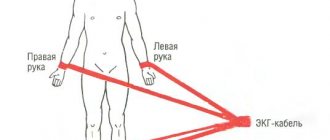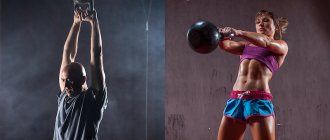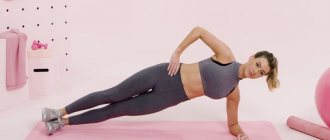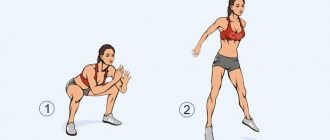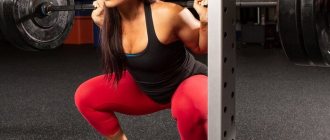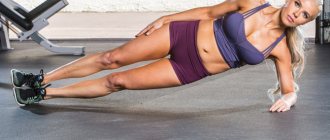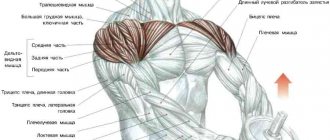Correct technique
The plank is a very effective exercise. He is underestimated by a lot of athletes. In appearance, it is a very easy exercise that is not capable of putting a lot of stress on your body. However, it is not. When performing the exercise, you engage the following muscle groups:
- Rectus and oblique abdominal muscles.
- Serratus muscles.
- Small of the back.
- Lat.
- Legs.
- Deltas.
Technique for performing the plank exercise:
- Take a lying position, as in push-ups.
- From this position, rest your forearms on the floor.
- Keep your back straight, do not lift your buttocks up.
- Look down.
- Your body should be in a straight line.
- Stay in this position until you collapse to the floor.
Now let's figure out exactly how your muscles tense.
For the first 10-20 seconds it seems to you that this is the easiest exercise in your life. Your muscles hardly tense up.
After 30 seconds of standing in a plank, you begin to feel a burning sensation in your lower abs. Your arms begin to tense slightly, it seems that you can’t stand any longer. However, this is not the case. Too often people underestimate their physical capabilities. This is what prevents them from progressing faster in sports.
After 40-50 seconds, you feel your entire abs starting to burn. Before this, only the lower part worked for you, but now the upper part is also included in the work. A slight burning sensation also appears in the lumbar muscles. But this is not the most difficult thing. the deltoids are the most stressed.
After a minute and a half of standing in this position, your lower back and abdominal muscles are burning, your arms are shaking, and you feel like you are about to collapse on the floor. The legs are also actively involved in the work, and such a wave of muscle tension passes throughout the body. After some more time, you can lower yourself to the floor.
Few people who do planks can hold out until their lats start to burn. You feel a burning sensation throughout your body. And then the lats begin to burn. They receive a static load from the very beginning of the exercise. They just need more time to properly load up.
This is the approximate time to complete the exercise for the average person. If a person is naturally weak, then he will not stand for 30 seconds. And if a person constantly trains, and his body is already accustomed to such loads, he begins to feel a burning sensation only after 2-3 minutes of holding the bar.
This was a classic version of the plank. Besides him, there are others:
- Side.
- With legs elevated.
- With arms raised.
- With an outstretched leg or arm.
- Place one hand or foot on the floor.
The side option is designed for high-quality work on the oblique abdominal muscles. Technique for its implementation:
- Place your elbow on one side of your body on the floor.
- Place the outer part of your foot on the same side as well on the floor.
- Your legs and torso should not be bent: your body should also describe a straight line.
- You need to stand in this position until you fall. After which, you can change sides.
Here you can hold out for much less time. This is understandable, because you are supporting only one part of your body, and you are holding the same weight.
The plank with your legs elevated shifts the load slightly. If you place your legs, for example, on a sofa, then the deltoids, as well as the lower part of your abs, will be more actively involved in the load.
As your arms rise, the load correspondingly shifts to the upper part of your abs. Only this version of the plank is lightweight. A novice athlete will be able to hold out for more than three minutes.
When performed with extended arms or legs, you significantly increase the load on your body. This should be done when the classic version of the plank becomes too easy for you. Remember, training should be hard. And only then will you achieve the desired result.
httpv://www.youtube.com/watch?v=embed/b4aF-P1n048
Benefits of planks for men and women
This is a difficult exercise, even if it doesn't seem like it. It takes little time, but brings a lot of benefits. Anyone can master the technique. It can be used by athletes as part of a training program, and by untrained people who want to maintain tone or get in shape. For men, the plank is useful:
- in the process of drying the body (static exercises are good for fat burning);
- to increase overall endurance;
- for the harmonious formation of the abs (the muscles of the back and abdomen are worked simultaneously);
- if you need to tighten your stomach;
- in combination with other exercises to maintain fitness.
After several weeks of training, the 30 second plank will be performed with a smile. Women, in addition, consider the plank to be an indispensable assistant:
- when fighting cellulite;
- for shaping the waist and athletic arms;
- to restore abdominal muscles after childbirth (not earlier than a month later, if the birth was without complications);
- for weight loss (if the exercise is used in combination with others and following a diet. Otherwise, the desired effect from the bar cannot be achieved, as from other exercises).
It is noteworthy that to achieve the effect, it is enough to systematically do the plank, alternating its variations. If done correctly and with full dedication, the result will be noticeable within two weeks.
Benefits of training
Performing the plank exercise is effective for everyone - men and women, professional athletes and amateurs.
This is a universal type of training that has a number of positive qualities:
- Suitable for all ages and fitness levels
- does not require much space or equipment
- allows you to quickly get in shape after childbirth or a long absence of training
- improves intracellular metabolism
What else can you do to lose weight faster?
Aerobic exercise
Doing aerobic exercise (cardio) is a great way to burn calories and improve your physical and mental health. Cardio is especially effective at removing belly fat, the unhealthy fat that accumulates around organs and causes disease.
Strength training
This will speed up your metabolism and prevent you from losing muscle mass.
Of course, it is important not only to lose fat, but also to gain muscle. Therefore, strength exercises are necessary
High Intensity Interval Training
Without spending a lot of time on exercise, you will speed up your metabolism, increase endurance, and burn additional calories.
How to do it right for a man
For the classic version of the plank, take a prone position, simultaneously stand on your elbows and on your toes, keeping your back straight. If you clasp your hands in your palms, the exercise will be easier, but not as effective. You can start with this pose. You will unlock the next level of difficulty if your hands are in a parallel position to each other
It is important to keep your elbows directly under your shoulders to avoid overstressing your joints.
The back should be straight, like a plank. Keep your head straight, do not arch your lower back as when doing push-ups. Watch the position of your pelvis; sometimes you involuntarily want to simplify the exercise and lift your buttocks up. To reduce the load on your lower back, tighten your leg muscles, align them like a string. You should feel your buttocks and stomach tightening. Don't forget to breathe evenly.
- You can do the plank with your arms outstretched. This is a simplified version of the exercise. Your palms should be directly under your shoulders. Maintain a 90-degree angle between your palms and wrist to avoid damaging your joints. Everything else should be done as in the previous version.
- An even simpler option is a knee plank. The body is straightened, the spine and neck are straight, the gaze is fixed on the floor in front of oneself, hands are on the elbows, palms are crossed. The exercise is suitable for beginners. It loads the abdominal muscles, back and forearms.
- There is also a more complex version of the plank - the side plank, which can also be used as an additional exercise to the first. To perform it, lie on your side and lean on one elbow. The second hand lies directly along the body or rests on the thigh. The legs are either parallel to each other, or the top leg goes forward. The back is straight, the body is elongated, the pelvis is raised, the abs are tense. The body resembles a “bar”. The exercise develops well the oblique abdominal muscles, muscles of the forearms, buttocks and the outside of the legs.
- One of the most difficult, but also effective types of planks is a side plank with a raised leg and an extended free arm up. This makes the muscles of the hips and arms work more actively. It is performed as follows: Stand in a side plank, leaning on your left elbow and leg, lift your right leg up. The foot should be slightly higher than the head. Extend your right arm straight up. Look straight ahead, not at your hand.
- The raised leg plank is more difficult than the classic version. The load on the trunk muscles increases significantly. To perform it, you need to stand in a classic plank position, and then raise one leg slightly above head level, extending your toes as much as possible. Hold this position for as long as possible. Also perform the exercise by changing legs.
- By doing a plank supported by one elbow, you can increase the load on the deltoid muscle of the forearm. To do this, get into a classic plank pose and extend one arm in front of you. Make sure your back doesn't arch. Try to maintain the pose for as long as possible, then repeat, leaning on the other elbow.
Benefits of planks for men
Let's start with the fact that the plank develops a very important quality for men - endurance. And this has a direct connection with pumping up your moral and volitional qualities
In other words, endurance is the patience of your muscles. If your muscles can withstand prolonged stress, then you are a resilient person. But for this you must withstand it mentally. This is how willpower develops. Therefore, every man needs to do this exercise.
Many people who have achieved success in business and sports claim that perseverance is a necessary, and often sufficient, condition for success. And in order to constantly persist, willpower is required. It is primarily pumped up when you do the plank.
Doing this exercise regularly will give you powerful and beautiful abs. Besides the fact that it will look great, it will also be very hard.
It really attracts girls' attention
The plank exercise has a powerful anabolic effect on your body. When you do basic exercises in the gym with heavy weights, all the muscles in your body become very tired. This is what stimulates muscle growth. When performing a plank, you also load the entire body, and it has an effect similar to basic exercises. If you are trying to gain muscle mass at home, then under no circumstances neglect this exercise.
If you want to lose weight, then you need to do this exercise. Firstly, accelerating anabolism helps you burn fat faster. Secondly, this exercise strengthens your abdominal muscles and greatly narrows your waist. Thus, by completing the plank, you kill two birds with one stone. By the time you lose fat, you will not just have a flat stomach, but strong abs with a narrow waist.
The plank exercise also has a positive effect on health. This exercise involves all the stabilizing muscles that hold the spine, thereby straightening it. If you perform the plank exercise, you reduce the risk of arthrosis and osteochondrosis. And if you perform this exercise along with hyperextension, then you will never experience sudden pain in your back.
How to do a plank: photo
Preparation
In some reviews, sports fans say that it is much more effective than pumping the press, push-ups and working with dumbbells. But you can achieve body improvement only if you perform the exercise correctly. It seems like a simple clarification, but, as practice shows, men often do not know the basic rules of the “plank”. Having looked briefly at a photo or video showing the execution of a pose, men still do it incorrectly, do not achieve the effect and begin to write reviews that the exercise is bad.
Let's figure out how to do this static exercise, and consider more complicated options that will allow you to pump up your abs and other muscles in a man's body even more.
The plank exercise is based on the fact that the body must be kept perfectly straight. The only problem is that without seeing ourselves from the outside, we may think that we are keeping our back straight, but in fact we are arching in a crooked position.
That is why, before “falling” into the “plank”, a man should remind his back what an aligned position is, remember the sensations in the muscles and reproduce them when performing the “plank”. Alignment is simple:
- Go to the wall, rest your heels, buttocks, shoulder blades and the back of your head against it.
- Pull your shoulders down, pull your pelvis forward a little so that your tailbone “looks” straight down. Tighten your abdominal and buttock muscles.
- There should be a natural deflection between the wall and the lower back - only the palm of your hand can pass. If the distance to the wall is greater, adjust the position.
- Hold the position for 10 breaths, take a step away from the wall, maintaining the pose. Remember the sensations - this is how the body feels with a straight back.
Static position technique
Like any other exercise, the plank has its own technique. Knowing the specifics of performing the position will ensure the safety and effectiveness of training.
Wear comfortable sportswear and shoes. Shorts, sweatpants, sneakers, a T-shirt or tank will do. Nothing should restrain or restrict movement.
Classic plank
Even such a simple position has many variations. Start with the classics, build consistency and keep experimenting.
- Lie on the floor, rest your toes and place your feet together.
- Tighten your back muscles and abs, and then rise with your arms outstretched. Your palms should be directly under your shoulders.
- Stop.
The first time will be difficult. Remember that there are no impossible tasks, the main thing is practice. Be sure to breathe, don't be shy about making noise. Inhale through your nose, exhale through your mouth. Puff if you have to, but most importantly, don't fall. If your body can’t handle it and you still fall, immediately get up again and stand until the end of the intended period of time. A woman will benefit from the plank exercise if she gives it her all. Remember every moment of the lesson: you are working for yourself and your body.
Do not allow your lower back to arch too much, as you will overwork yourself and may harm yourself. The entire body should be one continuous line.
To support the body, tighten your buttocks tightly, pull in your stomach, and hold your neck. The head should not be lowered to the floor and raised, it is a continuation of the legs and spine, one straight line.
Please note that a retracted abdomen should in no way affect breathing. It is breathing that will allow you to complete the bar well, saturate the body with oxygen and help you last as long as possible
It is also impossible to round your lower back and lift your pelvis upward. In this position, the load is weakened and the position becomes ineffective.
If, when performing a classic plank, you feel excessive tension in your legs, it is permissible to place your feet shoulder-width apart.
Elbow plank
The classic plank can be done on the elbows. You will need to stand on your toes and bent arms. The elbows should be strictly under the shoulders, the hands extended forward, the arms parallel to each other.
Don't be afraid of the burning sensation in your muscles - this is how your body works. Imagine yourself as a sphinx in the desert sands, lying almost the same way, leaning on its paws. The Sphinx is blown by hot winds, heated by the sun, but he doesn’t care. By being distracted by pleasant thoughts and visualizations, it will be much easier for you to meet the bar; you won’t have to track every second.
Don't forget that your back should be straight; don't fool yourself by arching your lower back towards the floor. It's unsportsmanlike.
Side plank
This type of static position is one of the most difficult. The benefits of this plank exercise for women have been proven in many fitness clubs and are very loved by Pilates and callanetics trainers.
When performing this exercise, the lateral press is strengthened.
Lie on your side. Place your feet on the floor so that the toe of one touches the heel of the other foot, as if you were walking along a narrow curb. Lift your body on one arm, the other on your waist. Stop.
The side position can be performed on the elbow.
Plank with raised leg
You can strengthen your legs well by increasing the load on them. The leg elevated plank exercise is beneficial for women who want to show off toned thighs and strong calves.
You need to take the “plank on your elbows” pose, lift one leg off the floor and keep it in a 45-degree position, without lowering it until the end of the exercise.
Inverted plank
This is a very interesting exercise and allows you to strengthen the so-called core muscles. This group of muscles is responsible for supporting the hips, spine and pelvis.
Lie on your back. The fulcrum points will be the heels and elbows. Rise up on your elbows, lifting your calves, buttocks, back and shoulders off the floor. Stop.
Options for men
The “plank” exercise for the stronger half of humanity has more than thirty variations, some of which can challenge even trained athletes. Here are some variations:
"Extended bar." It differs from the classic version with straight arms in that the straight arms are extended forward without bending to the maximum possible limit. At the same time, the “plank” line should be preserved, that is, there should be no deflection in the back or neck, as well as passive hips. "Windshield wipers." This version of the exercise is very similar to the movement of windshield wipers in a car. From the starting position, as you exhale, bend your right knee and touch it to your left hand, while pausing after exhaling, reach for your right hand with your knee, trying to raise your leg as high as possible and return it to the starting position as you inhale. Repeat on the other leg. Try to do the entire set to the possible limit, without violating the basic requirements for the “bar”
It is also very important not to twist your torso or shoulders, but to give all the load to your abs and hips. This option can be performed both on straight arms and on the forearms, making the load on the body more varied. The wall exercise is considered “aerobatics” among the variations of this exercise.
How to do it correctly: build a “plank” in the same way as a regular one, only your feet are not on the floor, but on the wall. Press your feet firmly into the wall, activating your hips, glutes, and core muscles. It’s better to start at a level where your feet are slightly higher than your shoulders, gradually approaching parallel to the floor. Important! Do not bend the lumbar spine, lifting the tailbone into the ceiling; on the contrary, tuck it tightly under the stomach, working hard with the internal muscles of the pelvis.
What does it affect?
The use of a large number of muscles significantly expands the scope of this exercise for both professional athletes and ordinary people.
What are the results of doing the plank exercise?
- Helps you lose weight
- Improves overall tone
- Pumps up the press
- Creates a muscle corset
- Forms posture
- Relieves muscle tension after an intense workout
- Serves for training the muscles of the buttocks and sides
- Increases stamina
Thanks to this efficiency, and the fact that no special equipment or a lot of time is needed, the plank has gained popularity.
When should you not do a plank?
For those who have never practiced the plank, it may seem like a harmless activity. However, an unprepared person can barely hold on in this position for half a minute.
Therefore, before experimenting with health, it is important to familiarize yourself with the contraindications to exercise.
- Pregnancy. Since the plank puts stress on the abdominal muscles, there is no need to practice the exercise during pregnancy. This will lead to serious complications, including miscarriage.
- Intervertebral hernia is a serious reason for limiting physical activity, including this exercise. People who have or have recently undergone surgery for a hernia in the abdominal area should also refrain from taking it.
- Pinched nerves and injuries to the back, neck, shoulders and other types are contraindications to performing the plank.
- Diseases of internal organs for which physical activity is prohibited.
In all these cases, you need to refuse to do the plank, as it is dangerous and can lead to irreversible consequences.
Watch your back!
For any exercise, even the most useful one, there will always be people who should stay away from it. The plank is contraindicated for a number of diseases.
1. First of all, these are any injuries to the back and neck: bruises, fractures, intervertebral hernias, pinched nerves.
Sore joints are the second to be hit , since they will have to take on a significant load.
3. Although to a lesser extent, internal organs are still at risk. The efforts that an athlete has to put in indirectly affect them and if, say, the pancreas or liver is already affected by some kind of ailment, the bar will aggravate it.
What gives
One of the most popular exercises for developing abdominal muscles is the plank. What does the load give in general:
- The work involves not only the abdominal muscles, but also the legs, back, buttocks, and arms;
- not only the superficial part of the muscle corset works, but also the so-called “deep” muscles;
- The bar helps to recover from injuries when performing other exercises is impossible;
- Regular exercise helps develop endurance;
- using a plank, you can develop muscles before performing more traumatic movements;
- the muscles are put to work almost immediately after the start of the exercise, which allows them to be worked out as much as possible.
The exercise has become widespread due to a number of factors:
- it can be done at home, no equipment is required;
- The exercise time is relatively short, which is perfect for people with limited free time;
- there are many options for doing the plank, which will allow you to diversify your workout and change the emphasis of the load on other muscles;
- the load is accessible to almost everyone, it is increased by increasing the time the exercise is performed;
- There are no special contraindications.
What muscle groups are involved?
When performing a plank, the following muscle groups are involved:
- Legs. The main emphasis is on the leg muscles; throughout the entire time they are under significant tension.
- Buttocks. At the beginning of the movement they contract and remain in this position throughout the entire time.
- Hands. They are also a fulcrum when doing planks.
- Breast. Thanks to the pectoral muscles, the correct position of the arms is ensured.
- Abdominal muscles, including the abs and obliques.
- Back. This group provides fixation of the spine.
The plank is used to a greater extent to work on the abdominal muscles, but this is not entirely the right approach. In essence, this is a general strengthening exercise aimed at working almost the entire body.
Does it help you lose weight on your belly and sides?
Losing weight in the abdomen and sides is only possible in combination with the rest of the body.
The plank cannot be aimed at local fat burning. The mechanism for reducing body fat is that it is necessary to force the body to use its own fat as energy. This is possible with a calorie deficit, which is achieved through belly fat loss exercises and diet.
The plank will help expend energy and trigger recovery processes, which will to some extent enhance weight loss.
For more effective weight loss, it needs to be combined with other movements - cardio and strength. Before you properly do the plank for weight loss at home, you need to create a clear training plan that will meet all the conditions necessary for losing weight.
What is pumped during execution
The genius of the “plank” is that while standing statically in one position, almost all muscles are pumped - look at the photo how the whole body tenses during the exercise. Or study a diagram that shows the muscles working during the exercise.
How long does it take to do the plank to get the desired effect? You need to start with ten breaths and exhalations. Each time it is worth increasing the time until it reaches 1-2 minutes. It is recommended to do the plank three to four times a day. After a month, when standing in a “plank” position becomes familiar to the body, you can complicate the exercises - add modified versions to the basic pose that enhance the pumping of specific muscles.
What is the use of a plank?
- It will make the practitioner more resilient: thanks to toning and strengthening all the muscles of the body, including the shoulders, arms, waist and lower back, but above all, the rectus abdominis muscle, which contracts and remains in tension the entire time the position is held. In addition to everything, the exercise develops such character qualities as perseverance and perseverance, because staying in one position for a long time without moving is a serious test.
- Very useful for posture and spine: men with a trained back and abs are much less likely to suffer from slouching. Doing this exercise will help you maintain a straight posture while standing or sitting. In addition to the trapezius and rhomboid muscles, it trains the erector spinae muscle. In a person with good posture, the bones are positioned correctly, which means that the internal organs are placed in a natural position, and breathing is not disturbed. And of course, the man in this case visually looks slimmer and taller.
- Heals the spine and back muscles, reduces the likelihood of injuries and pain: as a rule, the bar does not pose a danger if there are uncomplicated diseases of the intervertebral discs, since the spine does not stretch or bend. The back muscles work without straining the spine. A healthy back, in turn, prevents the formation of degenerative osteoarthritis. With developed abdominal muscles, the back remains straight, pain in the shoulders and neck is quite rare.
- Promotes the formation of the relief of the abdominal muscles: because the rectus, oblique and transverse muscles are “involved” in the work. If a man doesn’t train much, performing a single exercise will not get rid of fat and will not form beautiful abs, but together with other workouts and supplemented with a proper diet, the plank helps to methodically “make” the body athletic.
- Improves metabolism: This exercise will bring health benefits to men with sedentary work and low physical activity. Standing in the plank for a few minutes will improve your metabolism and the beneficial effect will last throughout the day.
- Helps get rid of stress: any workout changes your state of mind for the better, but in addition, the stretching effect of the plank eliminates muscle tightness. Relaxing and relieving tension will help relieve stress.
- Stretching the muscles of the legs and back will increase flexibility.
- The best firming effect for arms, thighs, buttocks and legs.
- Serves as a prevention of pain in the lumbar region, a common problem in men, by training the muscles in this area.
- Vestibular and balance training.
- Provides comprehensive healing of the whole body.
- It will be useful for professional athletes who are “drying” to burn excess fat.
Benefits of plank exercises for men
The benefits of such activities for men are as follows:
- During a handstand, almost all major muscle groups of the back, thoracic region, abdomen, arms, and legs are actively trained in the human body.
- By strengthening the muscle corset, posture improves and gait becomes light and beautiful.
- Regular exercise increases the body's endurance and prepares muscles for further training.
- Standing in this position trains the vestibular apparatus.
In addition, the benefit of the plank exercise for men also lies in the preventive plan. People who do this regularly are less likely to experience back and lower back pain.
Correct technique
The algorithm for performing the movement is very simple, but nevertheless, be attentive to the details, learn how to stand in the plank correctly, competent technique is the key to success.
- Lie on your stomach. Place your elbows on the floor at shoulder level. Place your forearms on the floor. Bent arms should form an angle of 90 degrees. Straighten your legs and now lean on your toes and forearms. Feet can be placed together or spread hip-width apart. Make sure your elbows are under your shoulders.
- Tighten and straighten your entire body. Your body should be in one straight line from head to toe.
- Do not bend your spine, do not lift your pelvis;
- Tighten your abs;
- Breathing is smooth and calm.
There are many variations of this exercise. But if you master the technique of performing the classic plank, then there will be no problems with other options.
httpv://www.youtube.com/watch?v=embed/KucnO3WYjfA
What does exercise do for a man?
All software packages aimed at creating a beautiful, toned body include this exercise. Its popularity has contributed to the emergence of many myths about the ease of implementation and the exaggerated effect of the training. Therefore, from the very beginning we will clearly distinguish between reality and fiction.
Benefit
Many trainers recommend a 10-minute stand in one of the plank variations to tone the muscle corset. You shouldn’t believe that this exercise will develop all the abs on your stomach in a few days or help you get rid of extra pounds. But at the same time, its result cannot be underestimated.
And it consists of this:
- The training helps develop willpower, because being motionless in the same position while holding your own weight is very difficult.
- During the training process, the main muscle groups of the body are involved. Prolonged static tension helps to strengthen them, which, together with proper nutrition and other types of physical activity, is the basis for creating body relief.
- The plank helps to painlessly develop the muscle group of the back in case of displaced spinal discs and various injuries. It is also an effective preventative against osteochondrosis and degenerative osteoarthritis.
- Forms correct posture. With regular exercise, stooping is eliminated. Moreover, men who stand for 10–20 minutes every day continue to keep their back straight even outside of training time.
- Helps develop body flexibility.
- Stimulates metabolic processes.
- Helps get rid of psycho-emotional tension and relieves stress.
Important! Blood flow to the muscles weakens in proportion to the increase in static tension. This means that excessive loads completely block the muscle capillaries, pinching their tissue.
Thus, the supply of oxygen and glucose is suspended in the most affected areas, which increases the load on the heart and circulatory system of the body. This is why the maximum stand time is limited to 20 minutes.
Contraindications
There are selective cases where such activities can be harmful. These include voluntary attempts to reduce the load, when the body weight is distributed to a greater extent on the vertebra, arms and neck. Then, after the lesson, severe pain appears in the lower back, or simultaneously in several affected areas.
The plank is also dangerous if it is contraindicated.
Find out which three types of planks for every day are suitable for both women and men.
These include:
- hernias on the spine;
- various pathologies of internal organs, excluding any kind of physical activity;
- injuries to the shoulder girdle and spine;
- heart defects, hypertension and other ailments of the cardiovascular system;
- colds, flu, acute respiratory infections.
Recommendations and tips
At the end of the story, I would like to give some advice and recommendations to ensure that your efforts are as effective as possible:
- To increase the load, the feet must be connected.
- Keep your abs and buttocks tight throughout the plank.
- The lower back should not bend.
- The head and neck are in line with the entire body.
- Do not squeeze your shoulder blades.
- The plank is an exercise that can be done every day.
- The optimal number of approaches is 4 for 30-60 seconds with a rest interval of about half a minute, no more.
If you are a beginner, then start your workouts by holding the exercise for 15 seconds, but not staying long at this time, but gradually increasing it (based on how you feel).
You should not start exercising immediately after eating - it is reasonable to wait 1.5-2 hours (if the food was not too heavy)
After the load, also sit down at the table after the same period of time, which is very important for those who want to lose weight
Having mastered the technique of performing the plank, all that remains is to make your workouts regular, adjust your diet and enjoy the positive changes in your body and health, leaving positive feedback.
Variety of planks
Recently, in addition to the classic static plank, a number of workouts have used dynamic variations of the exercise.
The pose is maintained, but other muscle groups are also actively involved:
- raise your straight legs straight up
- bring the knee under the body to the opposite hand
- We carry the leg bent at the knee over the side to the head and back
- lift the body and move it to one side
- rise from your elbows to your palms and hold the pose
- side plank - the body turns to the side, the weight is held on the arm (or elbow) and the edge of the foot
- reverse plank - face up, emphasis on outstretched arms and heels
- bend your knees (keep your body and hips in line)
- crossed arms plank
